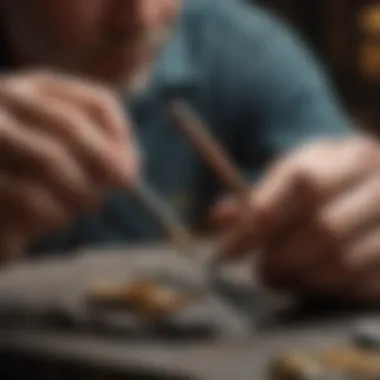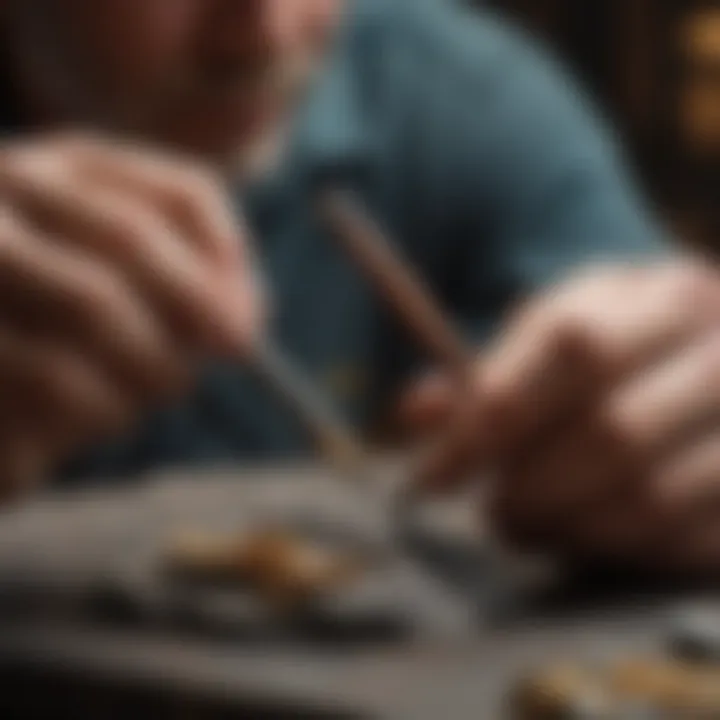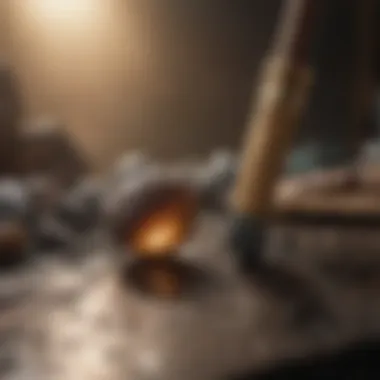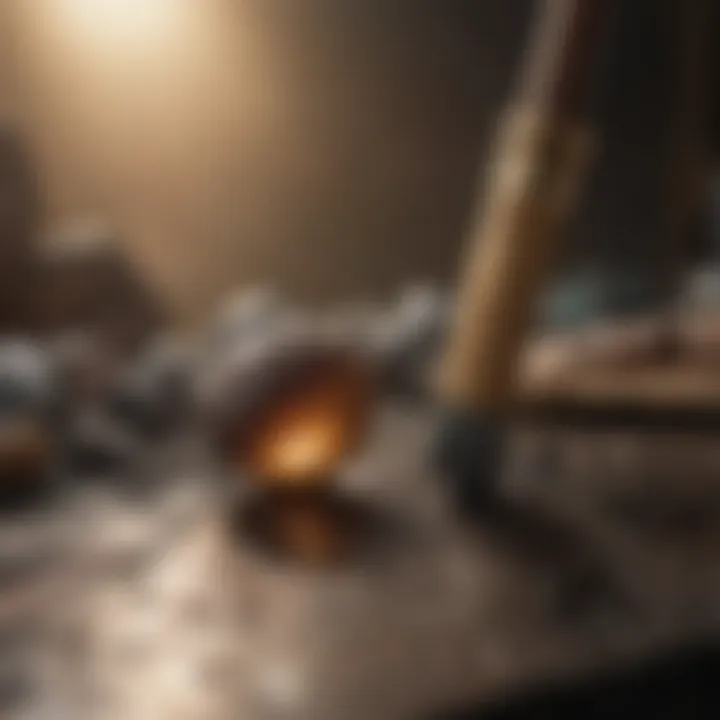Essential Insights on Lapidary Dop Sticks for Gemstone Artisans


History and Origins
The craft of lapidary—cutting, shaping, and polishing stones—dates back thousands of years. The use of dop sticks, a vital tool in the process, has a rich history intertwined with the evolution of gemstone artistry.
Ancient Practices
In ancient civilizations like Egypt and Mesopotamia, artisans used rudimentary forms of dop sticks made from stone or bone. The concept of attaching a gem to a stick facilitated easier handling while they worked on intricate designs. Although the techniques were primitive by today's standards, they laid the groundwork for modern lapidary techniques.
Evolution of Materials
Over time, the materials used for dop sticks have progressed significantly. Initially crafted from whatever was available, practitioners began experimenting with wood, metal, and even plastics as they discovered new properties of these materials. The choice of material often depended on the type of stone being shaped; for instance, softer stones required gentler handling, thus influencing the design and composition of dop sticks.
"The dop stick is more than just a tool; it's an extension of the artisan's hand and mind, allowing for precision and creativity to flourish."
Historical Significance and Cultural Impact
Throughout history, dop sticks have played a role not just in craft but also in trade and culture. For instance, lapidary skills were often taught within families, passing down knowledge across generations. In many cultures, gemstones were believed to carry spiritual significance, and the careful crafting of these stones was a sacred practice, worthy of specialized tools like dop sticks. As global trade expanded, so did styles and techniques, with each culture adding unique twists to the craft.
Identification and Classification
Understanding the various types of dop sticks is crucial for anyone delving into this art form.
Common Types and Variations
Dop sticks can be classified into different categories based on their materials, shapes, and intended uses:
- Wooden Dop Sticks: Traditional and versatile, suitable for most types of gemstones.
- Metal Dop Sticks: Often used for more delicate stones that require a sturdier grip.
- Plastic Dop Sticks: Lightweight and easy to clean, these are great for beginners.
- Specialty Dop Sticks: These come in various shapes and sizes designed for specific gemstones or cutting techniques.
Each type comes with its own set of advantages—while wooden sticks might offer warmth and a good grip, metal sticks provide durability and precision.
Guide to Identifying the Right Dop Stick
When selecting a dop stick, consider the following factors:
- Gemstone Hardness: Softer stones may benefit from wooden dop sticks, while harder gems may require the robustness of metal.
- Size and Shape of the Gemstone: Larger stones may need longer sticks for better control.
- Personal Preference: Ultimately, the choice often boils down to what feels right in your hand.
By understanding the historical context and types of dop sticks available, artisans can elevate their craft and ensure they are using the appropriate tools for their specific needs.
Prelude to Lapidary Dop Sticks
The world of lapidary work revolves around precision, skill, and the right tools, one of which is the dop stick. Understanding dop sticks is not just for the seasoned lapidarist; rather, it’s crucial for anyone looking to explore the gemstone crafting scene. Dop sticks are simple yet vital tools that allow gemstone professionals to handle, shape, and polish their gems with finesse. Their use ensures that valuable stones are treated with care, significantly affecting the quality of the finished piece.
Defining Dop Sticks
In essence, a dop stick is a tool used to hold a gemstone when it's being cut or polished. They come in various forms, but the common feature across all is the stick's ability to provide a secure method for gripping the gem. Typically, they are tapered or pointed at one end to allow easy manipulation while working with intricate designs.
The traditional dop stick is often made from wood, but nowadays, you can find them crafted from metals like aluminum and stainless steel. Each material brings its own set of advantages—wood might offer a lighter feel while metal could provide more durability.
The Role of Dop Sticks in Lapidary Work
The role of dop sticks in lapidary work cannot be overstated. When shaping or polishing stones, precision is key. A well-designed dop stick helps artisans maintain firm control over the gemstone, allowing them to execute delicate movements without the risk of dropping the stone.
"Dop sticks serve as an extension of the lapidarist’s hands, enabling them to focus on their artistry without worrying about losing grip."
Using a dop stick properly can also minimize the chances of breakage, especially with softer stones that are prone to cracking under pressure. Furthermore, having the right dop stick means being able to work on a variety of gem shapes and sizes, simplifying the often complex tasks involved in lapidary work.
Materials for Crafting Dop Sticks
When it comes to lapidary work, the materials used to create dop sticks can make a world of difference. Choosing the right material is crucial not just for the functionality of the dop stick but also for the quality of the gemstones being worked on. Factors such as durability, weight, and ease of use play significant roles in this decision. This section aims to shed light on two primary options available to lapidary artists: wood and metal, alongside a broader look into synthetic materials that are now bustling into the scene.
Wood vs. Metal: Pros and Cons
Wood and metal dop sticks each come with their own unique set of advantages and drawbacks. Understanding these can guide users to select the best fit for their specific needs.


Pros of Wood Dop Sticks
- Lightweight: Wood dop sticks tend to be lighter, making them easier to handle over long periods.
- Cost-Effective: Generally, wood options come at a lower price point, a great perk for those just starting out.
- Natural Grip: Wood often provides a more comfortable hold, reducing fatigue during extended use.
Cons of Wood Dop Sticks
- Durability: Wood can be susceptible to warping or cracking, particularly in environments with fluctuating humidity.
- Less Versatile: While suitable for many tasks, they might not be ideal for high-precision work that requires a steadier hand.
Pros of Metal Dop Sticks
- Rugged and Durable: Metal dop sticks can stand up to more intensive work, boasting a longer life, particularly helpful for professional lapidaries.
- Precision: The rigidity of metal can assist in making more exact moves, leading to cleaner cuts and better finishes.
- Multiple Uses: They can often be adjusted or modified for different uses as the needs arise.
Cons of Metal Dop Sticks
- Heavier: The added weight can lead to hand fatigue, particularly when working for long periods.
- Costly: Metal options might require a higher upfront investment compared to wood.
Synthetic Materials in Dop Stick Production
In recent years, synthetic materials have started to enter the realm of dop stick production, and they offer compelling alternatives to both wood and metal.
- Composite Dop Sticks: Made from a mix of materials, they combine durability with lightweight design, ensuring they’re easier to handle without compromising strength.
- Proprietary Plastics: Certain modern plastics offer outstanding grip and heat resistance, which can be advantageous when using heat-setting adhesives.
- Customization Options: Many synthetic dop sticks come in various colors and styles, allowing lapidaries to express their individuality.
While synthetic materials might lack the traditional charm associated with wood or the sturdiness of metal, they can adapt admirably to their purpose, often exceeding expectations in high-paced environments.
Selecting the right dop stick is essential, as it can significantly impact the overall effectiveness of your lapidary work. A deeper understanding of the materials available directly influences the quality of your finished gemstones. Ultimately, whether you lean toward the rustic appeal of wood, the rugged reliability of metal, or the innovative edge of synthetics, the choice largely hinges on the specific requirements of your craft.
Techniques for Using Dop Sticks
Utilizing dop sticks effectively is a cornerstone of successful lapidary work. The precision required not only enhances the quality of the finished gemstone but also protects the material from potential damage. Understanding the techniques associated with these tools is crucial for both newcomers and seasoned artisans. With a few key practices, one can navigate the often delicate world of gemstone crafting with ease and confidence.
Doping Process Overview
The doping process is the method by which gemstones are attached to dop sticks for cutting and shaping. Properly executing this step dictates the success of the entire operation. The first part of this process involves selecting a suitable dop stick, followed by the application of an adhesive that is compatible with both the stick and the gemstone material. This step is crucial, as it is where many artisans may falter.
Usually, the key to a successful doping process lies in temperature management. Many collectibles might expand or contract due to heat fluctuations, thus understanding how temperature affects different materials is vital. Getting it right can mean the difference between a flawless finish and a disaster on your hands. After cleaning both the gem and the stick, a small bead of adhesive is placed and the stone is pressed firmly until set. Letting it cure properly ensures a firm bond that withstands the rigors of crafting.
Choosing the Right Adhesive
Selecting an appropriate adhesive can spell success or failure in dop stick usage. Common choices include epoxy, cyanoacrylate, and specialty dop adhesives. Each type has its own set of advantages and disadvantages:
- Epoxy: Known for its strength and resistance to temperature changes, epoxy works wonders for heavier stones. However, curing time can be an issue, requiring patience.
- Cyanoacrylate (Super Glue): This is often a go-to for quick fixes. It bonds rapidly, but may not handle the weights of larger stones well.
- Specialty Dop Adhesives: Made specifically for this purpose, these often combine the best features, offering strength and a manageable cure time.
In choosing the right adhesive, consider the type and weight of the gemstone. Heavier stones might need the robustness of industrial-grade epoxies, while lighter ones could do just fine with super glue. Always look at temperature ratings and drying times to suit your workflow.
Positioning Gemstones Correctly
Positioning is where the art of using dop sticks truly shines. Misalignment can lead to uneven cuts, which ultimately affects the aesthetic appeal of the gemstone. Here’s what to keep in mind:
- Center the Stone: It’s essential to position the gemstone’s center of gravity directly over the stick. You can usually find this by balancing the stone on your fingertip. If it tips too much in one direction, adjust accordingly.
- Flat Surface: Before dopping, ensure the base of the stone is completely flat. This not only aids in proper adhesion but also helps when it comes time to cut.
- Firm Pressure During Bonding: Once you’ve placed the stone, apply firm and even pressure. This encourages an even distribution of adhesive and helps prevent air bubbles from forming.
Proper positioning can lead to a smoother, more polished final product. Misalignments often creates more work later down the line.
Factors Influencing Dop Stick Selection
Selecting the right dop stick is paramount for any lapidary. The qualities of the dop stick affect performance and ultimately, the overall quality of the gemstone being crafted. Different gemstones bear varying characteristics, and understanding this can aid in making informed choices in the crafting process.
Different Types of Gemstones
When it comes to dop stick selection, one can’t ignore the diverse range of gemstones available. Each type of stone has distinct properties that warrant careful consideration. For example, softer stones like opal and turquoise require more delicate handling, leading artisans to prefer lightweight wooden dop sticks. On the flip side, harder materials, such as sapphires or diamonds, benefit from the sturdiness of metal dop sticks that provide precise control during cutting and polishing.
- Soft Gemstones:
- Hard Gemstones:
- Opal
- Turquoise
- Jade


- Diamonds
- Sapphires
- Rubies
This differentiation not only enhances user comfort but optimizes the outcome for each stone. As the proverb goes, you wouldn’t use a hammer to crack a nut. Match the dop stick material with the gemstone’s hardness to avoid unnecessary mishaps.
Gemstone Shape and Size Considerations
The shape and size of the gemstone hold significance in dop stick selection as well. Larger gemstones require a more robust dop stick to ensure stability during work. If the stick itself is flimsy, there is a real risk of the stone slipping or the dop stick breaking, leading to potential accidents and ruined projects.
Shape also plays a role here. If you’re dealing with odd-shaped gems, a narrower or differently shaped dop stick may facilitate better grip. Often, lapidaries find that a tapered stick is more effective for small, intricate gems that need a gentle touch.
Some considerations include:
- Larger Gemstones:
- Smaller or Uneven-Sized Gemstones:
- Heavier, metal sticks are preferable for added support and stability.
- Tapered or uniquely shaped dop sticks can improve handling, allowing for precision in polishing and cutting.
"In the world of lapidary, the right tools can make or break your creation. Consider the nuances of your gemstones to select the best dop sticks."
In summary, understanding the different types of gemstones along with their shapes and sizes will profoundly influence your choice in dop sticks. A wise selection minimizes risks and enhances performance, which is crucial for achieving exceptional results in gemstone crafting.
Historical Context of Dop Sticks
The historical journey of dop sticks reveals much about their role in the art of lapidary work. These tools, essential in securing gemstones for cutting and polishing, have evolved significantly over the years. Understanding their evolution and cultural importance sheds light on the craftsmanship that goes into gemstone artistry, providing vital context for both current practices and future innovations.
Evolution of Dop Stick Design
From primitive tools to finely crafted implements, dop sticks have come a long way. Early lapidaries utilized rudimentary sticks made of natural materials. For instance, it is noted that in ancient times, artisans often employed sticks from trees, affixing gemstones using simple adhesives like natural resins. As technology advanced, so too did the materials and designs of dop sticks.
In the 19th century, with the onset of industrialization, the introduction of metal dop sticks made their appearance. These provided enhanced durability and precision. Metal dop sticks are praised for their ability to withstand wear and tear, thereby increasing their longevity in workshops. The design of dop sticks became more ergonomic, with shapes that facilitated easier handling and greater control during the grinding process.
In recent decades, dop sticks have incorporated synthetic materials, offering a myriad of advantages like improved grip and resistance to heat. Lapidaries can choose from a variety of materials based on the specific requirements of their stones and techniques used, allowing for a tailored experience in gemstone crafting.
"The tools we use tell the history of our craft; they are a testament to the progression of skill and technology in lapidary artistry."
Cultural Significance in Gemworking
The cultural implications of dop sticks extend beyond their functional role. In various cultures, the craft of lapidary work is deeply intertwined with history and tradition. For example, in certain indigenous communities, gemstones are not merely materials; they are thought to carry spiritual significance. Here, the dop stick becomes not just a tool but a medium through which artisans connect with their heritage.
In other regions, such as India, the art of gemstone cutting and polishing has been passed down through generations, with each artisan infusing their craft with cultural narratives and symbolism. Dop sticks, in this context, reflect the personal journeys of the artisans, embodying a blend of tradition and personal expression in their design and use.
The stories carried through these tools underscore the creativity and dedication of gemstone professionals. They illuminate how various cultures have embraced and adapted lapidary practices, intertwining their beliefs, artistry, and daily life into the act of craftsmanship. Understanding this cultural backdrop not only enriches one’s appreciation for dop sticks but also fosters respect for the artistry involved in crafting beautiful gemstones.
Maintaining and Caring for Dop Sticks
Maintaining and caring for dop sticks is a crucial aspect that often gets overlooked, yet it plays a significant role in the longevity and performance of these essential tools. The effectiveness of dop sticks directly impacts the quality of the gemstones worked on, so taking steps to ensure their well-being can yield better results in lapidary work.
Dop sticks, like any tool, require regular upkeep. Simple practices can prevent buildup of grime and residue, ensuring a more precise application during the doping process. Moreover, taking the time to maintain these tools can save money in the long run—refurbished dop sticks can often perform just as well as new ones. Keeping them in good condition can also prevent breakage, which might result in lost gemstones or wasted time.
Cleaning Techniques
Cleaning dop sticks is an essential practice for any gemstone professional. Over time, residues from adhesives, oils, and dirt can accumulate, leading to a decrease in performance and an increase in mistakes during the cutting or polishing process.
Here are some effective cleaning techniques:
- Warm Soapy Water: Simply soak the dop sticks in warm, soapy water. This method works wonders for most residues. After soaking, use a soft brush to scrub away any stubborn bits, ensuring you reach all crevices.
- Alcohol Soak: For more stubborn substances, such as dried adhesive, rub the affected areas with isopropyl alcohol. The solvent breaks down the glue and makes it easier to wipe away.
- Microfiber Cloth: Using a microfiber cloth can help polish the surface of the dop sticks, removing fine particulates and preventing scratches.
Regular cleaning can drastically enhance the performance of dop sticks and ensure that your gemstones are handled with the greatest care.
Repairing and Refurbishing Dop Sticks
Even the most carefully maintained dop sticks might need a little TLC now and then. Repairing and refurbishing them is essential to keep them functional.


Here are some common repair techniques:
- Replacing Tips: Over time, the tips of dop sticks may wear down or break. Replacing a worn tip is straightforward—simply cut off the old one and attach a new one. You can find pre-made tips made of various materials, or you can fashion your own from wood or metal, depending on your preference.
- Sand and Reshape: If your dop stick is wooden and becomes rough or uneven, sanding it down to a smoother finish can restore its handling characteristics. Just make sure to apply an even pressure to maintain consistency in shape.
- Edging and Polishing: After repairs, the dop stick may benefit from a polishing to ensure there’s no damage lingering on surfaces. This can be achieved using polishing compounds specifically designed for wood or metal.
Ultimately, investing a bit of time and effort keeping your dop sticks in shape will pay off in the quality of your gemstone work. Collectors who deeply care about the items they create will undoubtedly appreciate the differences that well-maintained tools can offer.
Impact of Dop Sticks on Gemstone Quality
The quality of a finished gemstone often hinges on many nuances during the crafting process. One of those subtle yet pivotal aspects is the use of lapidary dop sticks. These tools not only help in the manipulation of gemstones for cutting and polishing but also play a significant role in preserving the integrity and structure of the stones themselves. As professionals in this field understand, the right dop stick significantly affects how well a gem can be shaped and enhanced while minimizing any potential damages.
Dop sticks ensure that gemstones are held securely during the grinding and polishing phases. When considering materials, the adhesive that bonds the gem to the dop stick also matters greatly. If not chosen correctly, it might not withstand the process of cutting, leading to a less than ideal result.
Precision Cutting and Polishing
Precision is the name of the game for gem cutters, and dop sticks make it all notably easier. By holding a gemstone firmly, they allow for more accurate cuts. When a stone wobbles or shifts, even slightly, it can result in the dreaded "sawing" effect, where the intended cut strays off course.
A robust dop stick provides stability that lets artisans focus on crafting the perfect facets of a gem, ensuring that lines remain clear and angles sharp. Moreover, this precision is critical when it comes to shaping stones that exhibit iridescence or unique patterns. The quality of light play often calls for meticulous angles, and any imperfection often can result in a less-than-stellar appearance post-polish.
With dop sticks acting as the bridge between the gem and the lapidary tools, a skilled artisan can achieve finishes that truly showcase the stone's inherent beauty. Not to mention, this steady grip helps sustain shapes during polishing, further enhancing overall quality.
Minimizing Breakage Risks
A common concern among gem cutters is breakage; each snap or chip can transfer what once was a beautiful piece of nature into something less desirable. Dop sticks, with their diverse materials and designs, can significantly reduce these risks. When working with fragile stones, such as opals or certain types of quartz, it's essential to select a dop stick that evenly distributes pressure and minimizes points of stress.
For instance, wooden dop sticks tend to possess a slightly cushioning effect, which can be beneficial for softer gemstones. Conversely, metal dop sticks can offer grip but may expose the gem to more pressure; thus, the choice greatly depends on the unique characteristics of the stone in hand.
In essence, selecting the right dop stick is as much an art as it is a science. By promoting stability and reducing the potential for fractures during crafting, lapidary tools ultimately contribute to higher quality gemstones. Emphasizing their impact not only highlights their importance in professional lapidary work but also elevates the entire craft to an art form where each choice has lasting implications.
Emerging Trends in Dop Stick Usage
Emerging trends in the usage of lapidary dop sticks reflect a notable shift in the practices and tools of modern gemstone professionals. While traditional methods continue to hold their ground, the integration of modern materials and adaptive techniques heralds an era of precision and efficiency unmatched by previous standards. These trends not only enhance the overall experience for lapidaries but also significantly improve the quality of the finished products. The discussions that follow will delve into innovative materials currently influencing the market and the adjustments in techniques that accommodate advanced equipment.
Innovative Materials on the Market
The materials employed in the crafting of dop sticks have transformed over the years, now offering an array of choices designed to meet varying needs. Here are a few noteworthy options:
- Carbon Fiber: This lightweight material is becoming increasingly popular due to its strength and resistance to wear. Since it's a non-porous substance, it can facilitate a cleaner doping process, preventing contamination from adhesive residues.
- Plastic Composites: These materials meld durability with flexibility. Moreover, they come in a spectrum of designs and colors, appealing to artisans who appreciate both function and aesthetics.
- Glass Fibers: Known for their exceptional strength, these fibers can withstand high torque, making them ideal for heavy-duty applications. They resist breakage, thus minimizing the risk of gemstone damage during cutting or polishing.
- Recycled Materials: More lapidaries are opting for eco-friendly choices. Dop sticks made from recycled materials are sustainable and cater to a growing audience concerned with environmentally friendly practices.
Using these innovative materials not only improves efficiency but also caters to the increasing demand for sustainability and functionality within the lapidary community. Such advances provide gemstone professionals with tools that are not merely functional, but also forward-thinking.
Adapting Techniques for Modern Equipment
As tools evolve, so too must the techniques that accompany them. Adapting to modern equipment involves more than just using new tools; it requires a mindset ready to embrace change. Here are several considerations for gemstone professionals:
- Technique Refinement: With advanced dop sticks, artisans must fine-tune their methods. The way they position and secure gemstones might change, demanding a recalibration of hand movements to maximize both efficiency and safety.
- Training and Skill Development: Workshops and training sessions now emphasize the integration of new technologies with traditional practices, encouraging lapidaries to upskill. Mastering the use of new materials and techniques ensures artisans remain competitive in a continually evolving market.
- Compatibility with Upgraded Tools: Many modern dop sticks are designed to work seamlessly with advanced lapidary machinery. This compatibility might necessitate re-evaluating existing practices and methods to optimize performance and results.
- Experimentation and Feedback: Customers often push for innovation. As lapidaries experiment with novel techniques and tools, collecting feedback becomes essential. This input not only informs future product developments but also fosters community engagement and knowledge sharing.
The adaptation process is crucial for any lapidary aiming to maintain relevance in the field. Merely sticking to the old ways could lead to stagnation, whereas embracing change can open doors to possibilities previously thought unattainable.
Change is the only constant in the world of lapidary crafts, and staying ahead of these trends will ensure that artisans not only survive but thrive.
With these emerging trends shaping the landscape of gemstone crafting, lapidary professionals are better equipped to challenge norms and elevate their craft to unimagined heights.
Closure and Future Perspectives
As we draw the curtains on this exploration of lapidary dop sticks, it becomes clear that the significance of these tools extends far beyond mere utility. Understanding the nuances of dop stick usage is critical in refining the art of gemstone crafting. The article has highlighted various aspects—from the materials used in constructing these tools to the techniques for maximizing their efficiency. The relevance of adaptability, a recurring theme, cannot be overstated, especially in an industry that constantly evolves.
The Importance of Adaptation in Lapidary Practices
In lapidary work, staying stagnant is not an option. Gemstone professionals must adapt to new techniques and tools that emerge with advancements in technology and changes in consumer demand. For example, the introduction of modern adhesives and synthetic materials has transformed how dop sticks are designed and utilized. Adapting to these innovations can enhance precision and efficiency, ultimately leading to higher quality gemstones.
Furthermore, as artisans refine their skills, the application of traditional methods alongside contemporary techniques can create a unique blend that sets one apart in the market. It allows craftsmen to push boundaries, question norms, and explore creativity in ways that were previously unimagined.
Final Thoughts on Dop Stick Utilization
Dop sticks, in all their variations, are the unsung heroes of gemstone shaping and polishing. Their proper utilization significantly impacts the final quality of the stones, feeding into a larger narrative of craftsmanship that values both skill and tool mastery. As gemstone enthusiasts invest their time and resources into crafting, understanding dop sticks becomes vital.
"The right tool in the right hands can turn the ordinary into the extraordinary."
Ultimately, embracing both the historical context and future potential of dop sticks can not only enhance craftsmanship but also foster a community that values expert knowledge and skill. Continuous learning and adaptation will ensure the longevity of these tools and the craft itself, highlighting the importance of dop sticks in the wondrous world of gemstones.



